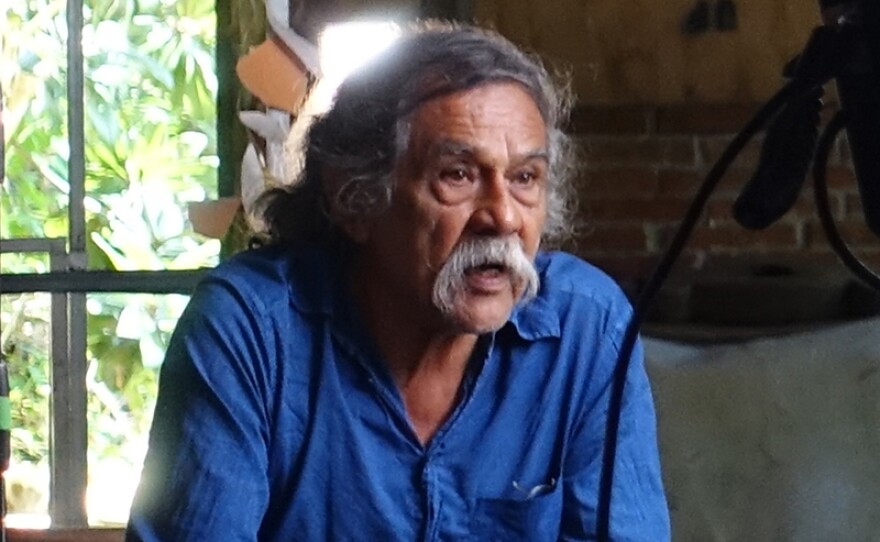Friday, Aug. 18, 2023 at 8 p.m. on KPBS 2 / Stream now with the PBS App
—Examine Original Hand-Crafted Works By Contemporary Artists—
Explore America's creative spirit through the language and traditions of the handmade. The Emmy-nominated and Peabody Award-winning series, CRAFT IN AMERICA, promotes and advances original handcrafted work and inspires people of all ages to pursue their own creativity. Explore the relationships and influences Mexican and American craft artists have on each other and on our cultures. This episode features traditional weaving and the creation of paper jewelry.
ARTIST BIOS:
Ofelia Esparza, educator and lifelong artist, is an “altarista,” a master altar-maker who teaches the meaning and history of Día de los Muertos (Day of the Dead) and creates the altars that commemorate loved ones who have passed away. She began this work in 1979 at Self Help Graphics & Art in Los Angeles, California, alongside founder sister Karen Boccalero. Ofelia’s strong commitment to keep the Mexican tradition of Día de los Muertos alive in the U.S. is visible in the heartfelt beauty of the community altars that she and her family erect annually for the celebrations at Grand Park in downtown Los Angeles.
J. Isaac Vasquez Garcia, master weaver and dyer in Teotitlán del Valle, Mexico, pioneered the revival of the use of pre-Hispanic Zapotec and Mixtec natural dyes on pure wool by the local weavers in the 1950s.
Isaac’s three sons, five daughters and their families take great pride in keeping this tradition alive despite the more time-consuming and expensive nature of these methods when compared with the more modern use of chemical dyes and acrylic fiber. They perform all steps by hand, taking the raw wool to finished rug: carding, spinning, dyeing and weaving. Their designs are drawn from both modern and Zapotec sources.
Alejandro de Ávila Blomberg, botanist and anthropologist, is the director of the Ethnobotanical Garden of Oaxaca, Mexico, established in 1993 with the help of artist Francisco Toledo. Also a knowledgeable textile scholar and curator at the Oaxaca Textile Museum, Alejandro recounts the history of cochineal, the highly prized red dye, considered one of the great treasures of the new world, and how it brought tremendous wealth to Oaxaca during the Spanish Colonial period. He has had and continues to have an important impact on the development of arts and culture in Oaxaca.
Jim Bassler, weaver and teacher, was introduced to the craft traditions of Europe, the Middle East, and Asia at an early age. The ethnic textiles that inspired him during these early travels became the foundation for his work. Over the years, Jim has continued to incorporate techniques from various ancient cultures, especially Navajo, pre-Columbian, Andean, and Mexican textile traditions into his artistic process.
For 25 years Jim taught textile art at the University of California, Los Angeles School of Arts and Architecture. He helped to establish the fiber/textile program at the Appalachian Center for Crafts in Smithville, Tennessee, has taught at the Arrowmont School of Arts and Crafts in Gatlinburg, Tennessee, and the Penland School of Crafts in Spruce Pine, North Carolina. With the help of the Mexican government, he initiated a weaving cottage industry in the isolated community of Capulálpam de la Sierra, Oaxaca, Mexico. His work has been exhibited in the U.S. and abroad and is held in numerous public and private collections.

Ceramic artist Veralee Bassler first took clay in hand around the age of 15 in a favorite high school class, ceramics. Several years later, she graduated from UCLA Art Department with a concentration in ceramics. Veralee then began a 25-year career of teaching in the Los Angeles Unified School District and currently, with her husband, Jim, has chosen to live an intensely creative life.
For four decades, Kiff Slemmons, artist/jeweler has celebrated non precious materials in her distinctive jewelry. She describes her inspirations as, “Tribal jewelry of Africa and the Arctic, writers like W.G. Sebald, artists like Man Ray and Marcel Duchamp, Inca stonemasons, and hand-activated tools and devices.” In 2000, Kiff was invited by Francisco Toledo Mexican artist and cultural activist, to design jewelry for his paper workshop, Taller Arte Papel Oaxaca.
Collaborating with local artisans to create jewelry using local plants like majahua, agave and cotton, and traditional dyes such as indigo, cochineal and ochre, this practice refers to the long history of paper-making in the region and holds a special significance in Mexico.
Slemmons is represented in numerous museum collections including:
- The Metropolitan Museum of Art and Museum of Arts and Design in New York, New York
- Museum of Fine Arts, Boston, Massachusetts
- The Museum of Fine Arts, Houston, Texas
- Tacoma Art Museum, Tacoma, Washington
- Mint Museum, Charlotte, North Carolina
- Honolulu Museum of Art Spalding House, Honolulu, Hawaii
- Victoria and Albert Museum, London, England

Francisco Toledo, known in Oaxaca as “El Maestro,” is regarded by many as Mexico’s most important and provocative living artist. He has been instrumental in building a series of highly successful public cultural institutions in the city that he calls home, Oaxaca:
- IAGO — a graphic arts museum and library
- MACO, a contemporary art museum
- Centro Fotográfico Manuel Álvarez Bravo
- Francisco de Burgoa Library, a rare book library in the recently restored Convent of Santo Domingo
- PRO-OAX, an environmental and cultural protection nonprofit organization
- El Pochote, an art cinema
- Taller Arte Papel Oaxaca, begun in 1998, in San Agustín, Etla, Oaxaca, using native fibers and renewable resources
- Jardín Etnobotánico de Oaxaca, an ethnobotanical garden that tells the history of the co-evolution of the plants and people of Oaxaca
In an effort to enhance public education and preservation of the environment, Toledo feels he is fulfilling a duty to the future of the people of his country.

WATCH ON YOUR SCHEDULE:
This episode and clips from this series are available on demand.
JOIN THE CONVERSATION:
CRAFT IN AMERICA is on Facebook, Instagram, YouTube, @CraftinAmerica on Twitter





